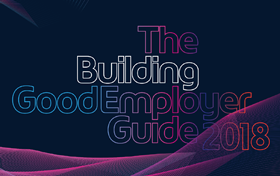Our new Good Employer Guide Award is looking at five key areas in which companies are working to keep their staff happy and feeling valued, encouraging innovation, and finding new ways to attract fresh talent


This year, the Good Employer Guide takes on a new format. In the past we asked companies to outline the range of benefits they offered employees, as well as their record on such measures as staff turnover and gender and ethnic balance.
As construction industry employers become increasingly sophisticated, it is getting harder and harder to differentiate between them through numbers only, so this year we decided to focus more on the qualitative rather than the quantitative. We still asked companies to tell us their full range of benefits, but we also asked firms to enter themselves into one of five awards categories – declaring whether they believed they were doing something special to support training; wellbeing; connection and communication; flexible working and parental policies; or recruitment, outreach and inclusion.
Management sought to give employees a greater voice in company decision-making to tap into a spirit of innovation
A range of benefits
As well as providing a guide for potential recruits to identify which companies are going above and beyond, this is an inspiring showcase of industry best practice and excellence. However, having a baseline of decent benefits is still important in attracting, retaining and getting the best out of your staff – as well as ensuring they are happy, healthy and fulfilled.
On average, the companies in the Guide offered a minimum of 24 days of annual leave (up from 23 last year), with staff at two architects – Assael Architecture and Doig+Smith – offering some of their employees 40 and 42.5 respectively.
There was clear evidence employers are taking an active approach to recruitment – looking beyond obvious sources of workers and making long-term efforts
On average, women made up 26% of non-administrative staff (2017: 27%). Architects demonstrated the most even gender balance, at 41% female employees, and contractors lagged behind at 8.3%. On average, 12% of staff in companies were non-white (the same as last year), with architects at 14%, consultants and engineers at 11%, contractors at 6% and housebuilders in the lead at 19%.
Consultants provided their staff with the most training hours – 55.5 compared with an overall average of 44.5 (down from 48 last year), while contractors offered 31.7 hours (although one entry had no available training data).
Of the companies in the Guide, 10 (29%) offered all staff the opportunity to work abroad, nine (26%) offered this to just some staff and the rest did not offer it at all. Businesses were more generous with sabbaticals – 21 (62%) companies offered the chance to take one to all staff and eight (24%) to at least some of their staff. All the firms said they recruited graduates, with an average of 15 participants on these programmes at present.
When it came to parental leave, 68% of all companies offered maternity benefits above the statutory minimum and 70% offered enhanced paternity benefits (even though only 0.4% of fathers took up the option of paternity leave). Each firm provided some form of private health insurance, with 53% of the companies offering all their staff private health insurance and 47% offering it to some of their staff.
And, at 15%, staff turnover was more or less equivalent to the previous year for the same set of companies, but this is up from the 12% reported by the companies that made it into the Guide in 2017.
Communication styles
The connection and communication category was made up predominantly of consultants and architects, and the prevailing effort seemed to be to make communication a bottom-up process, not just a top-down interaction. Management sought to give employees a greater voice in company decision-making to tap into a spirit of innovation, rather than simply telling them what was going on higher up.
AA Projects and Alinea Consulting were put forward in this category for the overall Good Employer Award – the former for its efforts to smooth the transition after a management buyout through measures such as a shadow board made up of employees; the latter for actively seeking new ideas from its staff through group discussions and ideas boxes. Others in
the group demonstrated similar efforts: ECD Architects asked its staff to tell them which values they felt the firm claimed to have that were not being lived in practice, HLM Architects held open studios to gather insights from workers, and Doig+Smith formed a business development steering group made up of staff.
When it came to recruitment, a contractor and a housebuilder shone out. Berkeley impressed with its drive to develop college construction training courses where they did not exist and to ensure learners stuck with these through mentoring, while contractor Severfield was selected for its daring initiative to recruit people with no experience and train them up in-house. Others focused on longer-term efforts to educate potential future recruits about the construction industry and careers within it through outreach to school and universities (Pozzoni Architecture) and bringing people in for talks and workshops (Alinea Consulting).
David Miller Architects stood out for its attention to the diversity of its workforce – for example, in recruiting for week-long work placements, it looks in particular to students who might not otherwise have access to the construction industry, and this ethos is backed up by real numbers – 60% of its non-admin staff are female and 28% from an ethnic minority background. There was clear evidence across the board that these employers are taking an active approach to recruitment – looking beyond obvious sources of workers and making long-term efforts to ensure the industry has a workforce for the future.
New learning techniques
In the training category, NG Bailey was one of the three nominees for the Good Employer Award – what was particularly striking was its use of a psychometric tool to create a personalised portrait of staff’s training needs and offering training via an app, but it also backed this up with solid investment, offering 5,100 training days in 2017 and spending more than £250,000 in the first year of its structured training programme.
Another on the shortlist, Rider Levett Bucknall, took advantage of its global network of offices by offering an exchange programme for staff to work abroad, which is helping form greater links between offices and provides a chance for different parts of the company to learn from each other. The third shortlisted firm in this category, Telford Homes, turned its attention to the industry’s ageing workforce by changing the entry criteria for its trainee schemes. Meanwhile, architect Orms specifically highlighted its efforts to prepare its workforce for the digital future – and present – with training in Revit, Union Square and InDesign software.
What changed this year?
Our editorial team scored more than 70 entrants both on their overall package and their specific initiative and the best 34 have been listed in the Guide. Of these, 10 companies have been chosen across the various categories for having the best initiatives. From this shortlist of 10, a panel of judges has chosen an overall winner – the name of which will be revealed at the Building Awards ceremony on 6 November.
Of the 34 companies that made it into the Guide, 13 (38%) were architects, nine (26%) were consultants, seven (21%) were engineers, three (9%) were contractors and two (6%) housebuilders. They had an average of 275 employees, ranging from architects such as David Miller with just 18 people to contractors such as NG Bailey with more than 2,500. This was up from an average of 260 employees in last year’s guide.
Healthier lives
Wellbeing, an increasing focus of employers’ attention across many sectors, attracted a range of approaches. Mental health was a key area this year – Assael Architecture, one of the nominees in this category, was selected for its exceptionally flexible working system and attention to its employees’ mental health, while contractor Graham, the other shortlisted firm, offered staff a personal development programme to help them lead healthier lives. Malcolm Hollis stood out for an initiative that seeks to equip both managers and staff with the knowledge and skills to have conversations about mental health, as well as offering a wide range of support and advice for people struggling with such problems.
Peter Brett Associates noted that engineers have a higher than average likelihood of being on the autistic spectrum, and is looking to work with the National Autistic Society to help develop interviewing techniques that are better suited to these candidates. Meanwhile, BPTW Partnership focused on softer aspects of the employment encounter – its cafe is a social space that offers activities such as wine tastings and sports screenings, as well as acting as a venue for regular sessions on presentation skills. It has a social budget of £32,000 for just 124 staff.
The flexible working and parental policies category was topped by HLM Architects for its efforts to make remote and agile working easier, with the other shortlisted companies – HTA Design and MSMR Architects – also demonstrating keen attention to work-life balance. Flexible working is a challenge for the construction industry, in which so much work is project- and site-based, but one that is increasingly important to attract staff.
Onwards and upwards
It has been a revealing exercise this year to find out about the initiatives that are being created, funded and committed to in the construction industry, and to understand the varying priorities of different firms.
With the following pages as a showcase of best practice, the hope is that other companies and individuals can be inspired in the development of their own excellent initiatives, and that next year the judges will have an even more difficult job selecting the best of the best.

Are you a good employer?
The process to find the winner of next year’s Good Employer Guide Award will begin in June 2019.
If you would like to be considered in next year’s survey please register and we’ll contact you when the process begins: www.building.co.uk/GEG19
Contact carolyn.leftly@building.co.uk if you require further information.
Building Good Employer Guide 2018

We have taken a fresh approach in this year’s Good Employer Guide, deliberately focusing on specific workplace initiatives designed to improve staff’s daily lives and, by extension, business performance
- 1
- 2
- 3
- 4
 Currently
reading
Currently
reading
Building Good Employer Guide 2018: Taking the initiative
- 6
- 7
- 8
- 9
- 10














































No comments yet